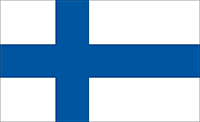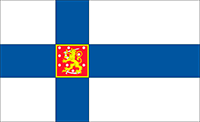The Finnish flag, also known as the Blue Cross Flag (Siniristilippu in Finnish), is made up of a blue cross on a white background.
The current flag was declared official on May 29, 1918, six months after Finland’s independence was declared.
The flag, whose colours represent the blue of the many Finnish lakes and the white of winter, has two models: the national flag and the official state flag.
Contenidos
The national flag

The Finnish national flag is rectangular in shape and measures 11 high by 18 wide.
The cross, which is located at a height of 4, has a width of 3. In relation to the length of the flag, this is 5 from the flagpole to the beginning of the cross, and 10 from the cross to the top. final.
The Scandinavian cross, which is also found on the flags of Norway, Sweden, Denmark and Iceland, is coloured PMS294C.
The state flag

The state flag presents some differences with respect to the national flag. In this case, the flag can be rectangular or have three points.
Additionally, the official state flag features the Finnish coat of arms at the intersection of the arms of the cross.
The rectangular-shaped flag is waved in Ministries and other official institutions, while the three-pointed flag is used by the Armed Forces. The president of the republic uses the three-pointed flag, but the blue and yellow cross of freedom appears in its upper left corner.
History of the flag of Finland
The flag of Finland was designed in the 19th century, long before its adoption after independence.
The design is linked to Fennomania, a 19th-century nationalist political movement that sought to adopt Finnish as the official language of the country.
The use of the colours blue and white as a symbol of the country is even older than the Fennoman movement since its use by different provinces, cities and even military detachments date back centuries.
Following the declaration of Independence, the Finns claimed a flag of their own. A call was made to design the new flag and two designs were chosen from among all the participants: blue and white, and red and yellow. Eero Snellman and Tuukkanen Brun are the ones who submitted the winning design.
Rules for using the Finnish flag
To use the Finnish flag it is necessary to comply with a set of rules and regulations imposed by the Ministry of the Interior.
First of all, the law establishes that any Finnish citizen, as well as the different municipal and regional bodies, have the right to display the flag.
The raising of the flag is mandatory in all public buildings, both provincial and national, while in private entities the raising is only carried out on the days of flag-raising established by the government.
Some of the significant dates on which the flag is raised are the following:
| February 5 | Runeberg Day |
| February 28 | Finnish Culture Day |
| April 9 | Finnish Language Day |
| April 27 | National War Veterans’ Day |
| May 1 | May Day |
| May 16 | Remembrance Day |
| June 26 | Day of the Finnish Flag |
| December 6 | Independence Day |
| December 8 | Jean Sibelius Day |
All those who have a flagpole must raise the flag at 8:00 in the morning and lower it twelve hours later, at 20:00 in the afternoon, and may be delayed until 9:00 p.m.
The day on which the independence of Finland is celebrated (December 6) must be hoisted throughout the day. And on San Juan’s Day (June 26), the hoisting takes place at 6:00 in the morning.
There are various laws related to the correct use of the Finnish flag that are mandatory for everyone, and there is even the possibility of being arrested for violating them.
Therefore, it is forbidden to use it in an irreverent way or to lower it from the flagpole without an official permit and outside the permitted hours, with the possibility of receiving a fine for treating the flag in a disrespectful way.
Nor is it possible to decorate the flag or sell it with colours or proportions different from those established by law.
The flag must also be kept in good condition at all times, without any breakage and completely clean. It must not touch the ground either and, if it is washed, it cannot be left to dry outside the home.
To get rid of a Finnish flag it is mandatory to burn it or cut it into very small pieces so that it is unrecognizable. It is not enough to throw it away. It is also not allowed to bury it to get rid of it.
As you explore Finland, keep an eye out for the flag that flies proudly from historic monuments and city squares, reminding visitors of the rich traditions and strong sense of national identity that permeate the Finnish way of life.
Take a moment to appreciate the significance of this iconic symbol and let it inspire you as you embark on your own Finnish adventure, immersing yourself in the captivating stories and enchanting landscapes that await you at every turn.
